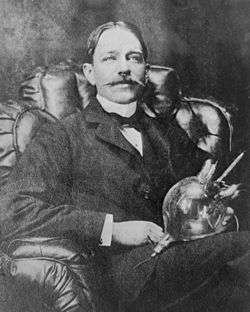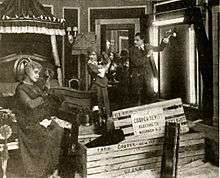Peter Cooper Hewitt
| Peter Cooper Hewitt | |
|---|---|
 Peter Cooper Hewitt holding his mercury vapor rectifier | |
| Born |
May 5, 1861 New York City, New York, U.S. |
| Died |
August 25, 1921 (aged 60) Paris, France |
| Nationality | American |
| Alma mater | Columbia University School of Mines |
| Known for | Arc discharge lamp, mercury-arc valve |
| Awards | Elliott Cresson Medal (1910) |
Peter Cooper Hewitt (May 5, 1861 – August 25, 1921) was an American electrical engineer and inventor, who invented the first mercury-vapor lamp in 1901.[1] Hewitt was issued U.S. Patent 682,692 on September 17, 1901.[2] In 1903, Hewitt created an improved version that possessed higher color qualities which eventually found widespread industrial use.[1]
Early life
Hewitt was born in New York City, the son of New York City Mayor Abram Hewitt and the grandson of industrialist Peter Cooper. He was educated at the Stevens Institute of Technology and the Columbia University School of Mines.[3][4]
Career

In 1901 he invented and patented a mercury-vapor lamp; a gas-discharge lamp that used mercury vapor produced by passing current through liquid mercury. His first lamps had to be started by tilting the tube to make contact between the two electrodes and the liquid mercury; later he developed the inductive electrical ballast to start the tube. The efficiency was much higher than that of incandescent lamps, but the emitted light was of a bluish-green unpleasant color, which limited its practical use to specific professional areas, like photography, where the color was not an issue at a time where films were black and white. For space lighting use, the lamp was frequently augmented by a standard incandescent lamp.[6] The two together provided a more acceptable color. Later. in the 1930s. a fluorescent coating (phosphor) was added to the inside of the tube at General Electric, which produced more pleasing white light when it absorbed the ultraviolet light from the mercury. This was the fluorescent lamp, which is now one of the most widely used lamps in the world.
In 1902 Hewitt developed the mercury arc rectifier, the first rectifier that could convert alternating current power to direct current without mechanical means. It was widely used in electric railways, industry, electroplating, and high-voltage direct current (HVDC) power transmission. Although it was largely replaced by power semiconductor devices in the 1970s and 1980s, it is still used in some high power applications. In 1903, the degree of Honorary Doctorate of Science was conferred upon him by the Columbia University in recognition of his work. [7]

In 1907 he developed and tested an early hydrofoil. In 1916, Hewitt joined Elmer Sperry to develop the Hewitt-Sperry Automatic Airplane, one of the first successful precursors of the cruise missile.
References
- 1 2 "Peter Cooper Hewitt". Encyclopædia Britannica.
- ↑ "Method of Manufacturing Electric Lamps". United States Patent and Trademark Office.
- ↑ Shaw, Albert (June 1908). "Leading Articles Of The Month: Peter Cooper Hewitt, Inventor". The American Monthly Review of Reviews. XXVII (6): 724. Retrieved 2009-08-07.
- ↑ University, Columbia (September 6, 1903). "Commencement Day". Columbia University Quarterly. V (4): 397–398. Retrieved 2009-08-07.
- ↑ "Unique Stunt by Whartons". The Moving Picture World. June 17, 1916. Retrieved November 13, 2013.
- ↑ The Boy Electrician by J.W. Simms, M.I.E.E (Page 280)
- ↑ "Obituary" (PDF). The Engineer: 236. 2 September 1921. Retrieved 20 February 2015.
Further reading
- Baker, Ray Stannard (June 1903). "Peter Cooper Hewitt – Inventor; Three Great Achievements In Electrical Science". McClure's Magazine. XXI: 172–178. Retrieved 2009-08-07.
- Burnett, Robert N. (March 1904). "Captains Of Industry, Part XXIII: Peter Cooper Hewitt". The Cosmopolitan. XXXVI (5): 556–558. Retrieved 2009-08-07.
- Buttolph, L. J. (September 1920). "The Cooper Hewitt Lamp: Part I. Theory And Operation". General Electric Review. XXIII (9): 741–751. Retrieved 2009-08-07.
- Buttolph, L. J. (October 1920). "The Cooper Hewitt Lamp: Part II. Development And Application". General Electric Review. XXIII (10): 858–865. Retrieved 2009-08-07.
- Buttolph, L. J. (October 1920). "The Cooper Hewitt Quartz Lamp and Ultra-violet Light". General Electric Review. XXIII (11): 909–916. Retrieved 2009-08-07.
- Hewitt, Peter Cooper (January 1902). "Electric Gas Lamps And Gas Electrical Resistance Phenomena". Transactions of the American Institute of Electrical Engineers. XIX: 59–65. doi:10.1109/T-AIEE.1902.4763958. Retrieved 2009-08-07.
- Pierce, George W. (February 1904). "On the Cooper Hewitt Mercury Interrupter". Daedalus. XXXIX (18): 389–415. doi:10.2307/20021910. Retrieved 2009-08-07.
- Prout, Henry Goslee (1921). A Life Of George Westinghouse, Chapter XVI "Various Interests and Activities" (The Cooper Hewitt Lamp). New York: The Scribner Press. pp. 236–240.
- Squier, George Owen (1908). "The Present Status of Military Aeronautics. III. Hydromechanic Relations. Relative dynamic and buoyant support". Annual Report of the Board of Regents of the Smithsonian Institution: 143–144. References Cooper Hewitt's hydrofoil work.
- (philadelphia, Franklin Institute; ), Pa (April 1903). "Notes and Comments. Cooper Hewitt Interrupter As An Aid In Wireless Telegraphy". Journal of the Franklin Institute. CLV (4): 315–316. doi:10.1016/s0016-0032(03)90227-4. Retrieved 2009-08-07.
- "The March Of Radio: Did Peter Cooper Hewitt Discover The Grid?". Radio Broadcast. I (6): 460–461. October 1922. Retrieved 2009-08-07.
- Sciences, National Institute of Social (October 1916). "The Awarding Of Medals: Presentation Medals". Journal of the National Institute of Social Sciences. II: 40–43. Retrieved 2009-08-07. References Cooper Hewitt's work with hydrofoils.